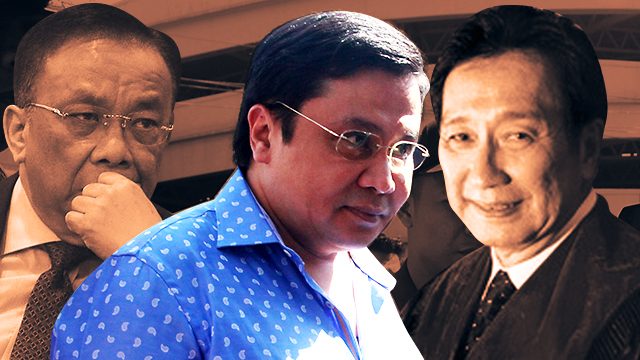SUMMARY
This is AI generated summarization, which may have errors. For context, always refer to the full article.

MANILA, Philippines – Four Supreme Court (SC) Justices dissented to the recent en banc decision which upheld the Office of the Ombudsman’s finding of probable cause against former senator Jinggoy Estrada of plunder, with two expressly voting to acquit him.
According to the decision and opinions released by the High Court on Friday, August 24, it was Associate Justices Presbitero Velasco Jr (newly retired), Lucas Bersamin, Diosdado Peralta, and Andres Reyes Jr who dissented in the narrow 6-4-4 decision.
The majority decision, written by Acting Chief Justice Antonio Carpio, dismissed Estrada’s petition and affirmed probable cause. He got concurrences from Associate Justices Teresita Leonardo de Castro, Mariano del Castillo, Estela Perlas-Bernabe, Marvic Leonen, and Noel Tijam.
Four Associate Justices – Francis Jardeleza, Benjamin Caguioa, Samuel Martires, and Alexander Gesmundo – inhibited.
Bersamin and Peralta have been shortlisted to become chief justice; while Reyes was dropped from the nominees. The short list was submitted to President Rodrigo Duterte late afternoon Friday.
Why is this relevant? We are finding out only now that it was the 4 justices who dissented in the decision promulgated July 31, and that Velasco and Bersamin voted to acquit Estrada.
Estrada went to the SC to challenge the Ombudsman’s finding of probable cause to charge him of plunder at the anti-graft court Sandiganbayan.
In his dissenting opinion, Velasco said the statements of the whistleblowers against Estrada were “insufficient to support such conclusion for being inadmissible in evidence.”
Velasco said Estrada should be dropped from the plunder charge. Bersamin adopted this dissent.
Peralta, on the other hand, said in his separate opinion there was “impropriety” in the indictment against Estrada, but voted to dismiss his petition for being moot as it is already ongoing trial at the Sandiganbayan.
Nevertheless, the SC in its announcement counted Peralta as a dissent. Reyes adopted Peralta’s dissent.
What were their reasons? Velasco invoked what is called the res inter alios acta; which, in essence, means the statement of an accused cannot be taken against another co-accused.
This refers to the admissions of the whistleblowers like Benhur Liuy, which, if the principle were to be applied, should not be taken against Estrada as an alleged co-conspirator.
Velasco said that the principle will not be applied under 3 conditions:
- The conspiracy must first be proven by evidence other than the admission itself
- The admission relates to the common object
- The admission was made while the declarant was engaged in carrying out the conspiracy
Velasco said the Ombudsman’s evidence such as Luy’s ledger and supposed endorsement letters signed by Estrada are “inadequate to presume his involvement in the scheme.”
“The same, however, does not adequately support the allegation that Sen. Estrada received commissions from Napoles, nor his involvement in the perpetration of these irregularities. His participation was limited to merely identifying the projects to be implemented and recommending its project partner,” said Velasco in his dissent.
On the 3rd condition, Velasco said the admissions were made long after the alleged conspiracy so it was not satisfied, and therefore the rule should be applied.
Peralta, on the other hand, said that Estrada shouldn’t have been separately charged with graft, because the crimes committed under the graft law are the same crimes necessary to prove plunder.
“In other words, is it possible for petitioner Estrada to commit plunder in the instant case without having committed the acts which were used as bases to charge him with violation of Section 3(e) of R.A. No. 3019? I submit that it is not,” said Peralta.
A court insider told Rappler that Velasco was the original member-in-charge of the petition, but he was outvoted, and so the case was reassigned to Carpio whose dissent won and became ponencia. (READ: SC acquittal of Arroyo helps Jinggoy Estrada get bail)
Jardeleza and Caguioa inhibited because they were involved in the case in their capacities as solicitor general and acting justice secretary, respectively.
Martires inhibited because he had just been appointed Ombudsman. There was no indicated reason for Gesmundo, but he was part of the Sandiganbayan 5th Division that handled the Estrada case in its early days.
What was Carpio’s decision? In his dissent-turned-ponencia, Carpio focused on the process and said the Ombudsman has the discretion to find probable cause our not.
Carpio noted that the Sandiganbayan also found probable cause.
“This Court held that once the trial court finds probable cause, which results in the issuance of a warrant of arrest, such as the Sandiganbayan in this case, with respect to Estrada, any question on the prosecution’s conduct of preliminary investigation becomes moot,” said Carpio, concurred in by 5 other justices.
Carpio said Velasco should not have assessed the strength or weakness of the evidence because it was a matter proper ventilated in the trial at the Sandiganbayan.
“The Court must defer to the exercise of discretion of the Ombudsman, in the absence of actual grave abuse of discretion on the part of the Ombudsman,” said Carpio. – Rappler.com
Add a comment
How does this make you feel?
There are no comments yet. Add your comment to start the conversation.